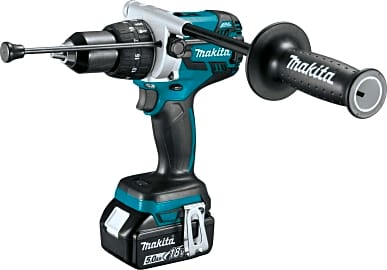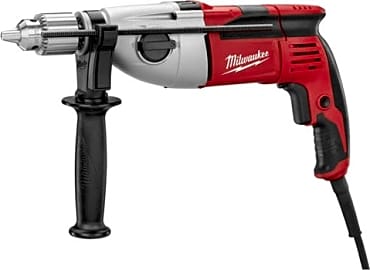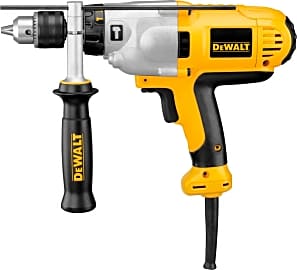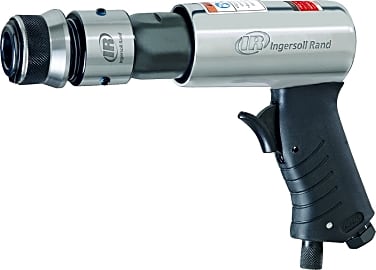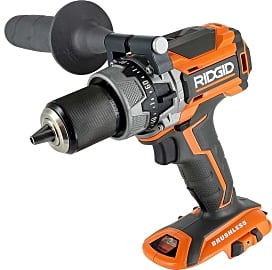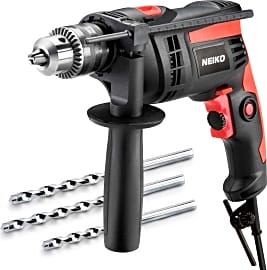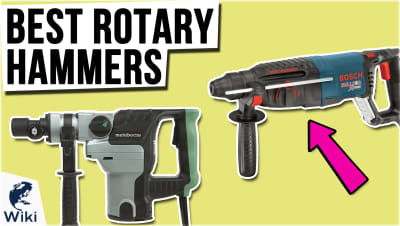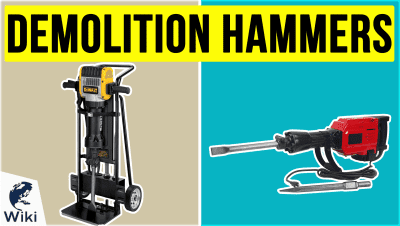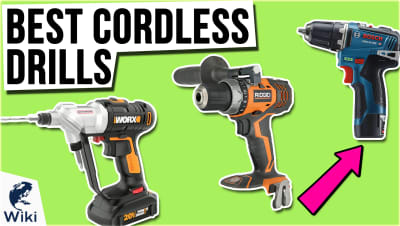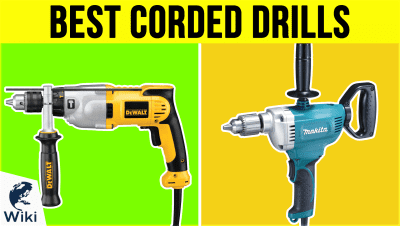The 10 Best Hammer Drills

This wiki has been updated 43 times since it was first published in March of 2015. When it comes to concrete, you might get away with using a standard drill and masonry bit to make the odd hole, but if your workload has you coming up against brick, mortar and cement frequently, a hammer drill is the tool you want in your arsenal. Our selections include both modestly-priced options for the average do-it-yourselfer, and top-end models geared toward professional contractors. When users buy our independently chosen editorial choices, we may earn commissions to help fund the Wiki.
Editor's Notes
December 01, 2020:
Whether you choose a battery-powered option or one powered from the main electricity supply, a good quality hammer drill is a versatile tool for homeowners and tradespeople alike. They are often at the cheaper end of the scale when it comes to power tools, and are suitable for small jobs around the home such as hanging picture frames, and boring holes in metal using their rotary only setting. The battery-operated versions are more popular for inserting fixings than boring holes as the hammer setting is particularly effective for driving screws into timber.
In this update, we made sure that the latest version from each company is featured in the ranking and removed any which have become obsolete. We replaced the DeWalt DCD996B with the DeWalt 20V MAX, a full kit that uses the same tried and tested tool, but now includes two lithium-ion batteries and a holster with storage for screw bits. The Bosch 1191VSRK was removed completely since it is very similar to the Bosch HD18, however, the latter has a more powerful, brushless motor and is only marginally more expensive. In its place, we added the Dewalt DWD525K, a corded drill with a 10 amp motor and a 360-degree locking side handle. Its mid handle design gives it a good balance and ensures a comfortable grip, even for extended periods of time. Of the battery-powered options, the Makita XPHO7TB is the most powerful, and is hardwearing enough for daily use on a worksite, but it is also the most expensive. The Porter-Cable PCC621LB is a much more affordable option that is durable enough for most household uses and comes with two batteries and a high-speed charger.
December 05, 2019:
This round of updates saw half of our rankings falling under scrutiny and getting swapped out due to availability issues and imminent obsolescence. The Black & Decker DR670 was replaced by a similarly budget-friendly alternative, the Skil HD182002, while the Neiko 10506A was replaced by the Neiko 10503A, a six-amp model offered for virtually the same price as its 4.2-amp predecessor. The Porter-Cable PC70THD was replaced by the Porter-Cable PCC621LB, and the discontinued Makita XPH012 18V LXT got switched out for the Makita XPHO7TB. We also cut loose two unavailable options from DeWalt, the DCD950B and DW511, although we included the DeWalt DCD996B.
A note on the difference between hammer drills and rotary hammers:
While these names are all-too-frequently used interchangeably, there is a technical difference that extends beyond which is big and which is small.
Rotary hammers depend on a crankshaft-driven piston to propel its hammering mechanism. They tend to be more powerful, typically have an SDS chuck (or SDS-Max, in the case of some larger models) and are equipped with hammer-only functionality that essentially transforms them to a miniature jack hammer. If you’re looking to drill anything larger than a half-inch hole, you want a rotary hammer.
Hammer Drills, contrastingly, have two ridged discs that rub against each other as their driveshaft turns, resulting in hammering oscillations that help drive your bit into tough materials like concrete and brick. Though they’re typically less powerful than rotary hammers, hammer drills are usually smaller, lighter and thereby easier to handle. They can often have their hammer function disengaged, which allows them to double as a standard power drill.
Though corded and battery-powered versions of both styles of tool are available, users going up against tough workloads will likely appreciate the consistent power of a corded option. Since we recommend hammer drills to users going up against lighter workloads, we also focused these rankings on decidedly convenient, battery-powered models. If you’re determined to stick with a hammer drill, but want a corded option, consider the Milwaukee 5380-21 or the Bosch HD18.
Hammer Drills and Rotary Hammers: Is There Really a Difference?
As one slides past the other, the ridges cause it to rise and fall.
It is not uncommon to see the terms rotary hammer and hammer drill used interchangeably when referring to power tools that are capable of both pounding and drilling, even by experienced construction workers. You would certainly be forgiven for thinking that these two tools are one and the same, but this is actually a misconception. Not only are hammer drills and rotary hammers different tools, but they are each best suited for certain kinds of tasks. Before we discuss which you should be using and when, let's start by breaking down how the two differ.
Inside of a hammer drill, there are a pair of ridged discs that rotate as the trigger is depressed. As one slides past the other, the ridges cause it to rise and fall. As it falls, it slams against the other causing the impacts that a hammer drill is known for. These ridges are very small, which in turn means the disc doesn't move very far as it rises and falls. Because of this, a hammer drill doesn't create a high impact force. It makes up for this in speed, though, as it is not uncommon for them to move at over 3,000rpm while under load and produce 40,000 or 50,000 blows per minute.
When the user pauses to take a break and removes the pressure on the chuck, the discs are separated by a clutch, which stops the pounding action and reduces motor wear. The majority of hammer drills can also be used in a drill only mode.
Rotary hammers have two pistons inside of them. One is driven by an electronic crankshaft. As it moves forward, it creates a pressure build-up inside of the cylinder where both pistons are situated. This air pressure is what drives the other piston, often termed the flying piston, forward to impact against the bit and create a hammering motion. Since these two internal components never actually touch, rotary hammers tend to be more durable and often last longer than hammer drills, even with heavy consistent use. Unlike hammer drills, rotary hammers also have a hammer only mode, essentially turning them into mini jackhammers when needed.
Hammer drills are best suited to light masonry work, such as drilling holes in bricks and concrete blocks, but should rarely be used on poured concrete for long periods as the motors tend to overheat, causing heavy wear and shortening their lifespan. They are also better for drilling through wood and metal, where faster speeds are needed. Since they don't have a hammer only mode, though, they cannot be used for demo work. On the flip side of the coin, they can be used for drilling into more sensitive materials where pounding could cause damage and can do double-duty as a power screwdriver.
The slow speed and high impact force of a rotary hammer makes it a poor choice when trying to produce holes in either of the aforementioned materials, but they excel at drilling through hardened concrete or stones. They can also be used for demolition work when set to hammer only mode.
If The Drill Fits, Wear It
Hammer drills are a lot like shoes; once you know your budget, you can make your decision based on comfort. Unless, of course, you make your decision based on style first, and then readjust your budget, in which case we have some nice glue for you to play with while the adults talk about hammer drills.
If money is no object, just grab our number one pick, it is pricey, but worth every penny. I'd also like to talk to you about a private investment opportunity. Whenever you have a minute; no rush.
We've made sure to specify which model is suited to who, taking out some of the guesswork on your part.
For the rest of us, all of the drills that made our best of list are still tenable, powerful options for our tool kits. All can get the job done, but some are better suited to daily, heavy-duty use, while our other choices are best for the home DIYer who only needs to tackle an occasional home repair or renovation. We've made sure to specify which model is suited to who, taking out some of the guesswork on your part.
This is where you can ask yourself another question: What's the nature of the job that's prompted this purchase? If it requires tighter, tougher angles, you might be better off sacrificing some power (and saving some money) by buying one of the more compact models. They may not work as well for masonry work, but will be better suited to tackling under-sink and low-space jobs where every inch counts. The same goes for those who don't want to deal with lugging around a heavy five or six pound drill. We have picked some nice four pound options just for you.
There is always the possibility that you just need to mindlessly drill holes in rocks like some demented steel-beaked woodpecker, in which case you would be better suited taking a look at our top rotary hammer picks.
Drilling Through Time
A lot of consumer products initially hit the market as the strongest, best-made version of themselves, only to be mimicked and cheapened over the years. Some others hit a peak of quality and innovation later in their development, only to be reduced to a shadow of their former selves over time (see: Apple post Steve Jobs).
It was in America, of all places, that the hammer drill jumped up from its cam-action roots to become the electro-pneumatic powerhouse that it is today.
Such gradual product degradation is, of course, the byproduct of free-market capitalism and unchecked corporate greed, but, hey, that's what makes America great.
The hammer drill, on the other hand, started out as a powerful, cam-action unit in Germany. Between the two companies Bosch and Fein there is a long-standing feud over who invented the thing first, but one of them got it out and about in the early part of the 20th century and the other followed suit.
It was in America, of all places, that the hammer drill jumped up from its cam-action roots to become the electro-pneumatic powerhouse that it is today. That was back in the late 60s, and the impact energy has gone up as unit weight and overall vibration shock has gone down.


